|
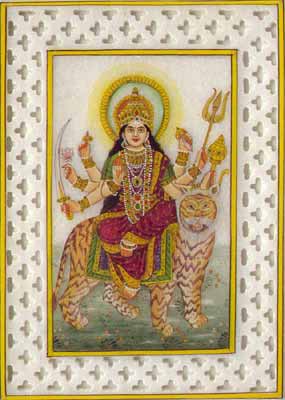 In India a woman with a fiery temperament is often nicknamed Durga
in recognition of the divine spark within her. She is the fervent autonomous goddess who knows how to stand for herself. In India a woman with a fiery temperament is often nicknamed Durga
in recognition of the divine spark within her. She is the fervent autonomous goddess who knows how to stand for herself.
The living traditions of India have always identified the female of the species with
all that is sacred in nature. But it is not always the warrior woman who is identified with the goddess, but also woman as
playful, lovable, and of course as the Mother. In a delightful vein it is conjectured that the kick of a woman is sufficient
and necessary for blossoms to spring from the sacred Ashoka tree. An entire ceremony has developed around this theme. Women
dance around this tree and gently kick it to bring it to bloom. Ancient Sanskrit poetry describes this happening through the
eyes of a jealous lover, who wishes that it were him, rather than the tree which benefited from the touch of her foot:
'She plucked its buds for her ear,
then repaid it with a gentle
kick
I might have been the one she struck,
She might have taken the bud from me,
but I'm cheated by a tree!'
 The idea being that by their mere touch, the fertilizing power
of a woman was transferred to the tree, which then burst into flowers. All things that arise from the earth in the form of
vegetative life mirror the great generative function of the Goddess. The process of transformation that is possible in mortal
woman mirrors the miracle of growth that occurs in nature. Such figures emphasize the importance of fertility and its associated
elements of bearing and nourishing children. The female figure is an obvious emblem of fertility because of its association
with growth, abundance, and prosperity. The idea being that by their mere touch, the fertilizing power
of a woman was transferred to the tree, which then burst into flowers. All things that arise from the earth in the form of
vegetative life mirror the great generative function of the Goddess. The process of transformation that is possible in mortal
woman mirrors the miracle of growth that occurs in nature. Such figures emphasize the importance of fertility and its associated
elements of bearing and nourishing children. The female figure is an obvious emblem of fertility because of its association
with growth, abundance, and prosperity.
There is also the suggestion that a tree is vulnerable to careless handling like a woman. A
tree that has come to flower or fruit will not be cut down; it is treated as a mother, a woman who has given birth. Thus the
metaphoric connections between a tree and a woman are many and varied. A relevant one here is that the word for "flowering"
and menstruation is the same in Sanskrit. In Sanskrit a menstruating woman is called a 'pushpavati', "a woman in flower".
Menstruation itself is a form and a metaphor for a woman' s special creativity. Thus a woman's biological and other kinds
of creativity are symbolized by flowering. It is interesting to note here that decoctions made from the bark of the same Ashoka
tree are used to soothe menstrual cramps and excessive blood loss during menstruation. The bark decoction also relieves the
pain and tension related to menopause.
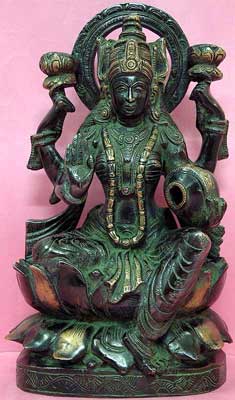 It comes as no surprise that prosperity and abundance too is visualized in the form of a female,
namely the Great Goddess Lakshmi. She is often shown holding a pitcher. This pitcher or pot in addition to being likened to
a womb, is said to be the pot of bounty, or the harbinger of prosperity. It comes as no surprise that prosperity and abundance too is visualized in the form of a female,
namely the Great Goddess Lakshmi. She is often shown holding a pitcher. This pitcher or pot in addition to being likened to
a womb, is said to be the pot of bounty, or the harbinger of prosperity.
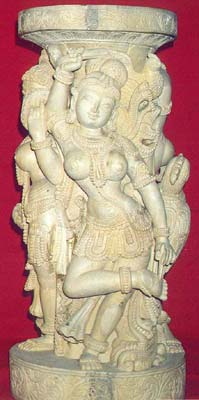 In extension of this conception, Indian aesthetic principles cutting across all schools,
sects, and traditions, state in a universal voice that all female forms should be endowed with abundantly full breasts, a
narrow waist and ample hips, symbolizing their child bearing capacities and also the power to nourish and sustain their creations,
a la Mother Nature. In extension of this conception, Indian aesthetic principles cutting across all schools,
sects, and traditions, state in a universal voice that all female forms should be endowed with abundantly full breasts, a
narrow waist and ample hips, symbolizing their child bearing capacities and also the power to nourish and sustain their creations,
a la Mother Nature.
Indeed Nilakantha Dikshita, an ancient aesthetician, lays stress on the milk of the
woman as goddess, sustaining the babies of the earth, her children. He fancies that he pearl necklace on the breast of a goddess
creates the illusion of drops of milk dripping and overflowing in fast succession from her moist bosom, in her great and surging
affection of motherhood, as she fondles us like babies. This has a parallel to the Great Greek Goddess of fertility, Gaia,
the Earth Mother, who is visualized with the mountains as her breasts, the caves her womb, and the earth's waters her female
fluids. Thus the body of a woman is nothing but the microcosm of the Earth, embodying in itself all the mysteries of creation,
and their solution.
The Buddhist art of India too displays these same symptoms. In the important Buddhist
stupa of Bharhut, belonging to around 100 BC, there can be observed an interesting phenomenon. On the railing that encircles
the main monument there are numerous sensuous female images. It would be easy to assume that these images were created in
order to satisfy the viewing pleasure of male devotees. But a study of the stupa's numerous inscriptions enables us to set
aside any such facile assumption. The railing was constructed as a result of community patronage in which the different parts
of the railing; pillars, crossbars etc., were donated by various individuals. The inscriptions reveal that many of these sensuous
figures were commissioned by women, including Buddhist nuns and monks, often identified by their names. Clearly there was
a higher purpose behind the exercise.
The Bharhut stupa was a sacred building built to enshrine a casket that contained a
portion of the relics of the Buddha after his cremation. Buddhist pilgrims visited the site to gain proximity to the relics
and to experience the unseen presence of the Buddha. Hence it was a ritual space and public domain. Male and female, young
and old would have made the pilgrimage and, in the course of repeated ritual circumambulating of the stupa, they would have
been exposed to these images. We find, then, that these images were not intended to be viewed as solely sensual objects.
We can thus be fairly certain that the function of such imagery was spiritual, and
relevant to the sacred structure to which it belonged. Even then their sensuous portrayal raises questions and requires reiteration
of the positive association of woman with fertility, growth, abundance, prosperity and hence, the auspicious.
Ancient art texts known as the 'Shilpa Shastras' confirm that the potency of women's
fertility and its equation with growth, abundance and prosperity led to women becoming a sign of the auspicious. In fact,
women served an apotropaic function whereby their auspiciousness was magically transferred to the monument upon which they
were sculpted or painted. A royal palace, a Buddhist stupa, a Hindu shrine, gained in auspiciousness and fortune when adorned
with the figure of a woman. A text of the tenth century, the 'Shilpa Prakasha', that provides guidelines for practicing temples
architects and sculptors, categorically states that figures of women are a prerequisite on the walls of temples. Its choice
of phrase underscores the significance of the theme. "As a house without a wife, as frolic (play) without a woman, so without
(the figure of woman) the monument will be of inferior quality and bear no fruit." Thus by the mere addition of feminine images
it was believed that a whole complex could become sacred and auspicious. In fact the same text lists the different types of
women who best sanctify a monument, and instructs the sculptor on how to exactly carve these figures. The most important of
these feminine images are:
- A Woman Dancing
- A Woman Adjusting her Anklets
- A Woman Drummer
- A Mother with her infant in her arms
- A Woman Smelling a Lotus
- A Woman Playing with a Parrot
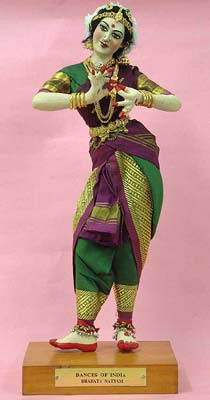 A Woman Dancing A Woman Dancing
Dance has been defined as a motion that arises from emotion. The
human body has a natural appetite for rhythm, and while dancing, not only does the dancer's body vibrate, but by its rhythmic
character, also spurs the viewers to a vibrating response. A primitive or a child emotionally aroused, say by some pleasurable
observation, will break into a dance of glee. Repeating that particular dance action can recapture the emotion, and thus in
dance, motion and emotion are interchangeable. The capacity for such interchange and build-up of feeling is at the root of
the identification of dance as a sacred overture.
Dance is an ancient and instinctive expression of the life force, and probably predates
drawing and painting as a form of creative activity. It is a form of magic: the dancer becomes amplified into a being endowed
with supra-normal powers, and her personality is transformed. Dance is also an act of creation. It brings about a new situation
and summons into the dancer a new and higher personality.
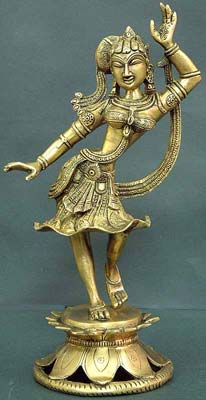 Underlying this celebration of dance is the distinct Indian attitude to the body
and the senses. Neither is a temptation nor snare. The relationship of the body, senses, mind, intellect and soul is articulated
in the Upanishads and is seminal to the world-view where the body is regarded as the abode of the divine and the divine descends
in the body. Logically, the body beautiful is the temple of god and dance is a medium of invoking the divine within. Each
form of dance - the stance, the movement and the context - is imbued with deep spiritual and symbolic significance. Dance
reflects a state of being at the highest order of spiritual discipline (sadhana) and is hence considered a yoga. Its performance
is a ritual act, a sacrifice of the personal self to a higher transcendental order. It is the medium which evokes the supreme
state of bliss (ananda) and also the vehicle of release (moksha). Underlying this celebration of dance is the distinct Indian attitude to the body
and the senses. Neither is a temptation nor snare. The relationship of the body, senses, mind, intellect and soul is articulated
in the Upanishads and is seminal to the world-view where the body is regarded as the abode of the divine and the divine descends
in the body. Logically, the body beautiful is the temple of god and dance is a medium of invoking the divine within. Each
form of dance - the stance, the movement and the context - is imbued with deep spiritual and symbolic significance. Dance
reflects a state of being at the highest order of spiritual discipline (sadhana) and is hence considered a yoga. Its performance
is a ritual act, a sacrifice of the personal self to a higher transcendental order. It is the medium which evokes the supreme
state of bliss (ananda) and also the vehicle of release (moksha).
The metaphor of dance also lies at the heart of many creation myths. The life force
expressed in the act of movement becomes a symbol of creation. Through the medium of dance, a woman embodies the progenitive
powers of cosmic energy, through whom, according to an ancient dance treatise 'the entire phenomenal world is kindled into
life.'
It does not come as a surprise therefore that in ancient times, a woman dancer was
considered an inseparable part of any ritual worship in temples. Every temple of consequence had attached to it one or more
dancers. Such women were known as Devadasis. These sacred dancers were symbolically married off to the presiding deity of
the temple. Thus an 'ordinary' human woman was found holy enough to be married off to a god, the Lord of the temple. The transformation
of an ordinary girl into a Devadasi was marked by important rituals, after the completion of which the woman was considered
'an ever auspicious woman' (nityasumangali). The traditional view holds that all women, by their very nature, share the power
of the goddess. The devadasi initiation rites celebrate the merger of her individual female powers with those of the goddess.
It is this quality of 'eternal auspiciousness' in a woman that brought into existence this tradition since the earliest times.
The importance of the devadasis can be gauged from the fact that their presence was
deemed necessary at the slightest event of importance taking place in the temple, for example bathing the deity in the morning,
or waving the sacred fire lamp in front of him. An important ritual was the participation in the twilight worship held at
sunset. The 'junction' of twilight, when the day slips into the night, is considered extremely dangerous, and so the gods
need all the support and attendance they can get. The ritual waving of the lighted lamp by a devadasi was considered the most
effective method of warding off an inauspicious state of the divine. Thus their participation in the affairs of the temple
was not restricted to dancing on important religious festivals and events, without which the celebrations were thought of
as incomplete, but also managing the day-to-day activities along with the officiating priest. But dance of course remained
their most accomplished contribution; indeed the life of a devadasi required a strict adherence to dancing schedules and practice.
Dance is potentially both sensual and hypnotic. Its passioned performance helped to evoke the atmosphere of the temple as
a place removed from the mundane world, the temple as a celestial abode of the deity.
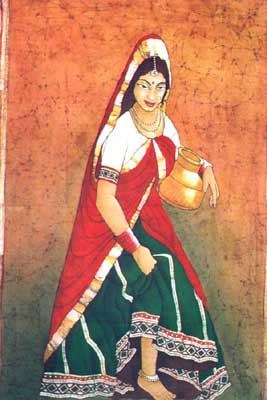 A Woman Adjusting her Anklets A Woman Adjusting her Anklets
The Indian tradition thinks of feet as impure. Even then the feet
of a woman are worthy of adornment, no less than any other part of her body. In fact the image of a woman adjusting her anklets
was considered sacred enough to be carved out in temple walls. A woman has no associated impurity, anything and everything
connected with her acquires a status over and above its material existence.
Wearing jewelry and adorning themselves with ornaments comes naturally to a woman.
Ancient texts identify sixteen different embellishments (solah-shringar), which acknowledge and celebrate the beauty and divinity
of the female form. Sixteen, a significant number, corresponds to the sixteen phases of the moon, which in turn is connected
with a woman's menstrual cycle. A woman of sixteen is considered to be at the peak of physical perfection in her life. This
is another pointer to the identification of the female with the spiritual. The anklet is mentioned as the last of these sixteen
ornaments.

It is not that women do not realize the spiritual potential of ornamentation. By adorning
their visible, material body, they also satisfy a universal longing for the embellishment of its intangible counterpart: the
human spirit. If this were not so, the desire for ornamentation could not have survived, nay thrived during the continuing
course of history.
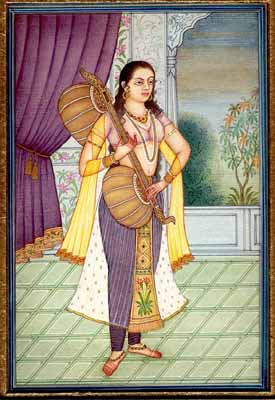 A Woman Drummer A Woman Drummer
In India music was linked with the origin of life itself, where sound is regarded as
the primordial vibration of divine energy.
Human mind has resorted to music, the language of symbols, achieving
in the process an inner unification of the mind by means of an outer integration of musical principles. Music at the summit
of its perfection has striven to symbolize the highest and innermost realities of the mind: a spring of self-expression which
eventually flows into the ocean of spiritual experiences. It aspires to be an art guided by knowledge and motivated by inspiration
to bring to man a sense of eternity and a state of ecstasy, which is all that he in his mortal frame can taste of immortality.
The purpose of music is to enable the mind to comprehend eternity and to enjoy ecstasy. On a practical level, music has a
high educational value, it ennobles the mind and awakens and feeds the aesthetic sense.
A lady playing a drum is a representation soaked in symbolism and rich in metaphorical
imagery. A drum represents thunder, the voice of cosmic energy. Of all musical instruments, the drum is the most primeval
means of communication, its percussive sound traveling to the heart and, by extension, suggesting the ability to communicate
with supernatural forces. |

